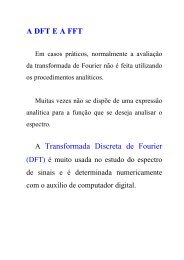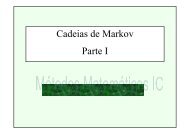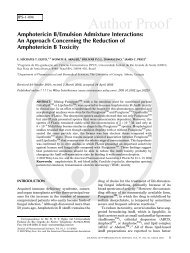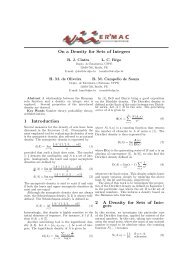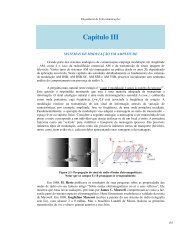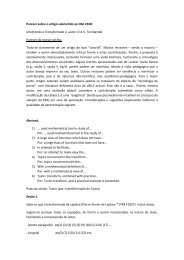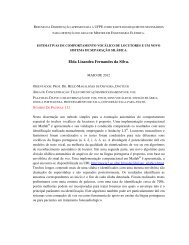A Family of Wavelets and ...
A Family of Wavelets and ...
A Family of Wavelets and ...
You also want an ePaper? Increase the reach of your titles
YUMPU automatically turns print PDFs into web optimized ePapers that Google loves.
Revista da Sociedade Brasileira de Telecomunicações<br />
Volume xx Número XX, xxxxx 2xxxx<br />
jθ<br />
0<br />
jθ<br />
0<br />
[ δ ( t + t )e + δ ( t − t )e ] ↔ cos( wt + θ )<br />
1<br />
−<br />
, <strong>and</strong><br />
0<br />
0<br />
0 0<br />
2<br />
B jw<br />
⎛ w − w ⎞<br />
0t<br />
0<br />
e .Sa( Bt) ↔ ∏⎜<br />
⎟ . ❏<br />
π<br />
⎝ 2B<br />
⎠<br />
It is interesting to check some particular cases:<br />
pcos( w; 0 , 0,<br />
0,B) ↔ PCOS( w; 0,<br />
0,<br />
0,B)<br />
⇔ B<br />
( ) ∏ ⎛ w<br />
⎟ ⎞<br />
.Sa Bt ↔ ⎜<br />
π<br />
⎝ 2B<br />
( ) ( )<br />
⎠<br />
pcos t;t0,<br />
0,<br />
0,B<br />
→ +∞ ↔ PCOS w;t0<br />
, 0,<br />
0,<br />
B → +∞<br />
⇔ 1<br />
[ δ ( t + t0<br />
) + δ ( t − t0<br />
)] ↔ cos( wt0<br />
), which follows from the<br />
2<br />
property <strong>of</strong> the sequence<br />
lim 1 t<br />
.Sa( ) = δ ( t ) . (7)<br />
ε → 0 πε ε<br />
Property 1. (Time shift): A shift T in time is equivalent to<br />
the following change <strong>of</strong> parameters:<br />
pcos( t − T;t0 , θ 0 ,w0<br />
,B) = pcos( t;t0<br />
− T , θ 0 ,w0<br />
,B).❏<br />
3.1 SCALING FUNCTION DERIVED FROM<br />
NYQUIST FILTERS<br />
In order to find out the scaling function <strong>of</strong> the new<br />
orthogonal MRA introduced in this section, let us take the<br />
inverse Fourier transform <strong>of</strong> Φ(w).<br />
The spectrum Φ(w) can be rewritten as a sum <strong>of</strong><br />
contributions from three different sections (a central flat<br />
section <strong>and</strong> two cosine-shaped ends):<br />
with parameters<br />
⎛ w ⎞<br />
⎛ w − π ⎞<br />
2 Φ(<br />
w ) = ∏⎜<br />
⎟ + cos( wt0<br />
+ θ0<br />
)<br />
B<br />
∏⎜<br />
⎟ +<br />
⎝ 2π<br />
− 2 ⎠<br />
⎝ 2B<br />
⎠<br />
⎛ − w − π ⎞<br />
cos( −wt0<br />
+ θ0<br />
) ∏⎜<br />
⎟,<br />
⎝ 2B<br />
⎠<br />
B := πα , t 1<br />
0 : = <strong>and</strong> ( 1 − α ) π<br />
θ0<br />
: = −<br />
.<br />
4α<br />
4α<br />
π<br />
(8)<br />
It follows from Definition 1 that<br />
2π<br />
Φ(<br />
w)<br />
= PCOS ( w;0,0,0,2π<br />
− 2B)<br />
+<br />
⎛ 1 (1 −α<br />
) π ⎞ ⎛ 1 (1 −α)<br />
π ⎞<br />
PCOS ⎜ w;<br />
, − , π , πα ⎟ + PCOS ⎜ − w;<br />
, − , π , πα ⎟<br />
⎝ 4α<br />
4α<br />
⎠ ⎝ 4α<br />
4α<br />
⎠<br />
<strong>and</strong> therefore<br />
( deO )<br />
2π φ ( t ) = pcos( t; 0,<br />
0,<br />
0,<br />
2π<br />
− 2B)<br />
+<br />
⎛ 1 ( 1 − α ) π ⎞ ⎛ 1 ( 1 − α ) π ⎞<br />
pcos⎜t;<br />
, − , π , πα ⎟ + pcos⎜<br />
− t; , − , π , πα ⎟.<br />
⎝ 4α<br />
4α<br />
⎠ ⎝ 4α<br />
4α<br />
⎠<br />
After a somewhat tedious algebraic manipulation, we derive<br />
( deO ) 1<br />
φ ( t ) = .( 1−α<br />
).Sinc[( 1−α<br />
)t ] +<br />
2π<br />
(9)<br />
1 4α<br />
1<br />
. . { cosπ(<br />
1+<br />
α )t + 4αt.<br />
sinπ(<br />
1−α<br />
)t}.<br />
2<br />
2π<br />
π 1−(<br />
4αt<br />
)<br />
A sketch <strong>of</strong> the above orthogonal MRA scaling function<br />
is shown in figure 4, assuming a few roll-<strong>of</strong>f values.<br />
φ deO (t)<br />
(<br />
The scaling function φ<br />
deO ) ( t ) can be expressed in a more<br />
elegant <strong>and</strong> compact representation with the help <strong>of</strong> the<br />
following special functions:<br />
Definition 2. (Special functions); ν is a real number,<br />
Hν ( t)<br />
: = νSinc(<br />
νt)<br />
, 0≤ν≤1, <strong>and</strong><br />
ν 1 2 | ν −ν<br />
|<br />
( t ) :<br />
[ ] { t ( )t. t}<br />
1<br />
2<br />
Μ<br />
1 cosπν<br />
2<br />
1 1 2<br />
2<br />
1 2t(<br />
1 2<br />
)<br />
2 ν ν sin<br />
ν<br />
=<br />
+ − πν<br />
2<br />
π − ν −ν<br />
❏<br />
It follows that:<br />
( Sha )<br />
2 π φ ( t ) = H ( t ) ,<br />
1<br />
( deO )<br />
1+<br />
α<br />
1−α<br />
Μ1<br />
− α<br />
2 πφ ( t ) = H ( t ) + (t ) .<br />
lim<br />
( deO )<br />
Clearly, ( t ( Sha )<br />
φ ) = φ ( t ) .<br />
α →0<br />
The low-pass H(.) filter <strong>of</strong> the MRA can be found by using<br />
the so-called two-scale relationship for the scaling function<br />
[7]:<br />
1 ⎛ w ⎞ ⎛ w ⎞<br />
Φ( w ) = H⎜<br />
⎟.<br />
Φ⎜<br />
⎟ . (10)<br />
2 ⎝ 2 ⎠ ⎝ 2 ⎠<br />
How should H be chosen to make eqn(10) hold? Initially,<br />
let us sketch the spectrum <strong>of</strong> Φ(w) <strong>and</strong> Φ(w/2) as shown in<br />
figure 5.<br />
The main idea is to not allow overlapping between the<br />
roll-<strong>of</strong>f portions <strong>of</strong> these spectra. Imposing that<br />
2π(1−α)>(1+α)π, it follows that α





